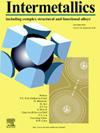CuCrCoFeNixTi高熵合金组织与性能的第一性原理与实验研究
IF 4.3
2区 材料科学
Q2 CHEMISTRY, PHYSICAL
引用次数: 0
摘要
设计了CuCrCoFeNixTi(x = 0,0.5, 1,1.5, 2.0)高熵合金(HEAs),并根据第一性原理建立了其固溶结构模型。得到了HEAs的晶格常数、相结构、弹性性能、态密度和微分电荷密度。模拟结果表明,合金的形成热为负。随着Ni含量的增加,HEA密度增大,晶格常数减小,泊松比增大,G/B值减小,柯西压力增大。表明HEAs由脆性向韧性转变。差分电荷密度图表明,HEAs内的电荷分布较为均匀,并表现出金属键的特征。态密度图显示CuCrCoFeNi2Ti的峰值态密度最高,表明其金属性能较高,韧性较好。最后,采用真空电弧熔炼法制备CuCrCoFeNixTi HEAs,并进行均匀化处理。观察了合金的显微组织并进行了压缩试验。结果表明,实验得到的XRD谱图与模拟结果相似,CuCrCoFeNixTi HEAs主要由FCC相结构组成。随着Ni含量的增加,HEAs的组织更加均匀,抗压强度从710.3 MPa提高到1878.5 MPa,伸长率从4.9%提高到14.7%。CuCrCoFeNixTi HEAs的断裂形貌为准解理断裂,主要表现为解理步骤和撕裂边缘。本文章由计算机程序翻译,如有差异,请以英文原文为准。
First-principles and experimental study on structure and properties of CuCrCoFeNixTi high entropy alloy
CuCrCoFeNixTi(x = 0, 0.5, 1, 1.5, 2.0) high entropy alloys (HEAs) were designed and the solid solution structure model were established based on the first principles. Lattice constant, phase structure, elastic properties, state density and differential charge density of the HEAs were obtained. The simulation results show that the heat of formation of the alloys are negative. With the increases of Ni content, the density of HEA increases, the lattice constant decreases, the Poisson ratio increases, the G/B value decreases and the Cauchy pressure increases. It indicates that the HEAs change from brittleness to toughness. The differential charge density maps show that the charge distributions in the HEAs are relatively uniform, and the metal bond characteristics are presented. The state density diagrams show that CuCrCoFeNi2Ti has the highest peak state density, which indicates that its metal properties are higher and its toughness is better. Finally, the CuCrCoFeNixTi HEAs were prepared by vacuum arc melting and the homogenization was carried out. The microstructures of the alloys were observed and the compression tests were conducted. The results show that the XRD patterns obtained by experiment are similar to those of simulation, and CuCrCoFeNixTi HEAs are mainly composed of FCC phase structure. As the Ni content increases, the microstructures of HEAs were more homogeneous, the compressive strength increased from 710.3 MPa to 1878.5 MPa, and the elongation rate increased from 4.9 % to 14.7 %. The fracture morphologies of CuCrCoFeNixTi HEAs present a quasi-cleavage fracture, which are mainly manifested in cleavage steps and tearing edges.
求助全文
通过发布文献求助,成功后即可免费获取论文全文。
去求助
来源期刊

Intermetallics
工程技术-材料科学:综合
CiteScore
7.80
自引率
9.10%
发文量
291
审稿时长
37 days
期刊介绍:
This journal is a platform for publishing innovative research and overviews for advancing our understanding of the structure, property, and functionality of complex metallic alloys, including intermetallics, metallic glasses, and high entropy alloys.
The journal reports the science and engineering of metallic materials in the following aspects:
Theories and experiments which address the relationship between property and structure in all length scales.
Physical modeling and numerical simulations which provide a comprehensive understanding of experimental observations.
Stimulated methodologies to characterize the structure and chemistry of materials that correlate the properties.
Technological applications resulting from the understanding of property-structure relationship in materials.
Novel and cutting-edge results warranting rapid communication.
The journal also publishes special issues on selected topics and overviews by invitation only.
 求助内容:
求助内容: 应助结果提醒方式:
应助结果提醒方式:


